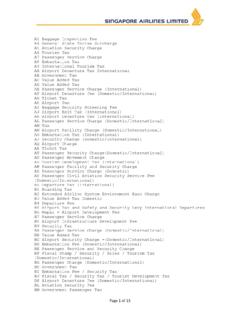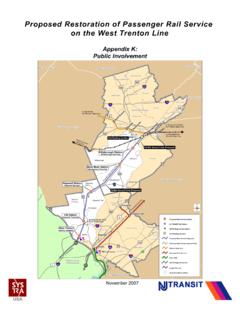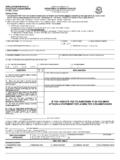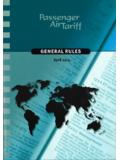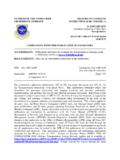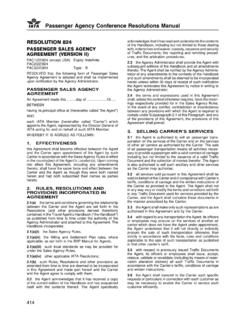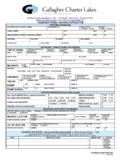Transcription of Rev. Proc. 2017-29 SECTION 1. PURPOSE
1 Rev. Proc. 2017 -29 SECTION 1. PURPOSE This revenue procedure provides: (1) tables of limitations on depreciation deductions for owners of passenger automobiles first placed in service by the taxpayer during calendar year 2017 , including separate tables of limitations on depreciation deductions for trucks and vans; and (2) tables of amounts that must be included in income by lessees of passenger automobiles first leased by the taxpayer during calendar year 2017 , including a separate table of inclusion amounts for lessees of trucks and vans. The tables detailing these depreciation limitations and lessee inclusion amounts reflect the automobile price inflation adjustments required by 280F(d)(7). SECTION 2. BACKGROUND .01 For owners of passenger automobiles, 280F(a) imposes dollar limitations on the depreciation deduction for the year the taxpayer places the passenger automobile in service and for each succeeding year.
2 For passenger automobiles placed in service after 1988, 280F(d)(7) requires the Internal Revenue Service to increase the amounts allowable as depreciation deductions by a price inflation adjustment amount. The method of calculating this price inflation amount for trucks and vans placed in service in or after calendar year 2003 uses a different CPI automobile component (the new trucks component) than that used in the price inflation amount calculation for other passenger automobiles (the new cars component), resulting in somewhat higher depreciation deductions for trucks and vans. This change reflects the higher rate of price inflation for trucks and vans since 1988. - 2 - .02 SECTION 168(k)(1) provides that, in the case of qualified property, the depreciation deduction allowed under 167(a) for the taxable year in which the property is placed in service includes an allowance equal to 50 percent of the property s adjusted basis (hereinafter, referred to as 168(k) additional first year depreciation deduction ).
3 The 168(k) additional first year depreciation deduction generally applies to qualified property placed in service before January 1, 2020. SECTION 168(k)(2)(F)(i) and (iii) increases the first year depreciation allowed under 280F(a)(1)(A)(i) by $8,000 for passenger automobiles placed in service by the taxpayer before January 1, 2018, and to which the 168(k) additional first year depreciation deduction applies..03 Tables 1 through 4 of this revenue procedure provide depreciation limitations for passenger automobiles placed in service during calendar year 2017 . Table 1 ( passenger automobiles that are not trucks or vans) and Table 2 (trucks and vans) provide depreciation limitations for passenger automobiles for which the 168(k) additional first year depreciation deduction applies. Table 3 ( passenger automobiles that are not trucks or vans) and Table 4 (trucks and vans) provide depreciation limitations for passenger automobiles for which the 168(k) additional first year depreciation deduction does not apply.
4 The 168(k) additional first year depreciation deduction does not apply for 2017 if the taxpayer: (1) acquired the passenger automobile used; (2) did not use the passenger automobile during 2017 more than 50 percent for business purposes; (3) elected out of the 168(k) additional first year depreciation deduction pursuant to 168(k)(7); or (4) elected to increase the alternative minimum tax (AMT) credit limitation under 53, instead of claiming the 168(k) additional first year depreciation deduction, for qualified property placed in service - 3 - during 2017 pursuant to 168(k)(4)..04 SECTION 280F(c)(2) requires a reduction in the deduction allowed to the lessee of a leased passenger automobile. The reduction must be substantially equivalent to the limitations on the depreciation deductions imposed on owners of passenger automobiles. Under (a) of the Income Tax Regulations, this reduction requires a lessee to include in gross income an amount determined by applying a formula to the amount obtained from a table.
5 Table 5 applies to lessees of passenger automobiles that are not trucks and vans and Table 6 applies to lessees of trucks and vans. Each table shows inclusion amounts for a range of fair market values for each taxable year after the passenger automobile is first leased. SECTION 3. SCOPE .01 The limitations on depreciation deductions in SECTION (2) of this revenue procedure apply to passenger automobiles (other than leased passenger automobiles) that are placed in service by the taxpayer in calendar year 2017 , and continue to apply for each taxable year that the passenger automobile remains in service..02 The tables in SECTION of this revenue procedure apply to leased passenger automobiles for which the lease term begins during calendar year 2017 . Lessees of these passenger automobiles must use these tables to determine the inclusion amount for each taxable year during which the passenger automobile is leased.
6 See Rev. Proc. 2012-23, 2012-14 712, for passenger automobiles first leased during calendar year 2012; Rev. Proc. 2013-21, 2013-12 660, for passenger automobiles first leased during calendar year 2013; Rev. Proc. 2014-21, 2014-11 641, as amplified and modified by SECTION of Rev. Proc. 2015-19, 2015-8 656, for - 4 - passenger automobiles first leased during calendar year 2014; Rev. Proc. 2015-19, as amplified and modified by SECTION of Rev. Proc. 2016-23, 2016-16 581, for passenger automobiles first leased during calendar year 2015, and Rev. Proc. 2016-23 for passenger automobiles first leased during calendar year 2016. SECTION 4. APPLICATION .01 Limitations on Depreciation Deductions for Certain Automobiles. (1) Amount of the inflation adjustment. (a) passenger automobiles (other than trucks or vans). Under 280F(d)(7)(B)(i), the automobile price inflation adjustment for any calendar year is the percentage (if any) by which the CPI automobile component for October of the preceding calendar year exceeds the CPI automobile component for October 1987.
7 SECTION 280F(d)(7)(B)(ii) defines the term "CPI automobile component" as the automobile component of the Consumer Price Index for all Urban Consumers published by the Department of Labor. The new car component of the CPI was for October 1987 and for October 2016. The October 2016 index exceeded the October 1987 index by Therefore, the automobile price inflation adjustment for 2017 for passenger automobiles (other than trucks and vans) is percent ( x 100%). The dollar limitations in 280F(a) are multiplied by a factor of , and the resulting increases, after rounding to the nearest $100, are added to the 1988 limitations to give the depreciation limitations applicable to passenger automobiles (other than trucks and vans) for calendar year 2017 . This adjustment applies to all passenger automobiles (other than trucks and vans) that are first placed in service in calendar year 2017 . - 5 - (b) Trucks and vans.
8 To determine the dollar limitations for trucks and vans first placed in service during calendar year 2017 , the Service uses the new truck component of the CPI instead of the new car component. The new truck component of the CPI was for October 1987 and for October 2016. The October 2016 index exceeded the October 1987 index by Therefore, the automobile price inflation adjustment for 2017 for trucks and vans is percent ( x 100%). The dollar limitations in 280F(a) are multiplied by a factor of , and the resulting increases, after rounding to the nearest $100, are added to the 1988 limitations to give the depreciation limitations applicable to trucks and vans. This adjustment applies to all trucks and vans that are first placed in service in calendar year 2017 . (2) Amount of the limitation. Tables 1 and 2 contain the dollar amount of the depreciation limitation for each taxable year for passenger automobiles a taxpayer places in service in calendar year 2017 .
9 Use Table 1 for a passenger automobile (other than a truck or van), and Table 2 for a truck or van, placed in service in calendar year 2017 for which the 168(k) additional first year depreciation deduction applies. Use Table 3 for a passenger automobile (other than a truck or van), and Table 4 for a truck or van, placed in service in calendar year 2017 for which the 168(k) additional first year depreciation deduction does not apply. REV. PROC. 2017 -29 TABLE 1 DEPRECIATION LIMITATIONS FOR passenger AUTOMOBILES (THAT ARE NOT TRUCKS OR VANS) PLACED IN SERVICE IN CALENDAR YEAR 2017 FOR WHICH THE 168(k) ADDITIONAL FIRST YEAR DEPRECIATION DEDUCTION APPLIES Tax Year Amount 1st Tax Year $ 11,160 - 6 - 2nd Tax Year $ 5,100 3rd Tax Year $ 3,050 Each Succeeding Year $ 1,875 REV. PROC. 2017 -29 TABLE 2 DEPRECIATION LIMITATIONS FOR TRUCKS AND VANS PLACED IN SERVICE IN CALENDAR YEAR 2017 FOR WHICH THE 168(k) ADDITIONAL FIRST YEAR DEPRECIATION DEDUCTION APPLIES Tax Year Amount 1st Tax Year $ 11,560 2nd Tax Year $ 5,700 3rd Tax Year $ 3,450 Each Succeeding Year $ 2,075 REV.
10 PROC. 2017 -29 TABLE 3 DEPRECIATION LIMITATIONS FOR passenger AUTOMOBILES (THAT ARE NOT TRUCKS OR VANS) PLACED IN SERVICE IN CALENDAR YEAR 2017 FOR WHICH THE 168(k) ADDITIONAL FIRST YEAR DEPRECIATION DEDUCTION DOES NOT APPLY Tax Year Amount 1st Tax Year $ 3,160 2nd Tax Year $ 5,100 3rd Tax Year $ 3,050 Each Succeeding Year $ 1,875 REV. PROC. 2017 -29 TABLE 4 DEPRECIATION LIMITATIONS FOR TRUCKS AND VANS PLACED IN SERVICE IN CALENDAR YEAR 2017 FOR WHICH THE 168(k) ADDITIONAL FIRST YEAR DEPRECIATION DEDUCTION DOES NOT APPLY Tax Year Amount 1st Tax Year $ 3,560 2nd Tax Year $ 5,700 3rd Tax Year $ 3,450 Each Succeeding Year $ 2,075 .02 Inclusions in Income of Lessees of passenger Automobiles. A taxpayer must follow the procedures in (a) for determining the inclusion amounts for passenger automobiles first leased in calendar year 2017 . In - 7 - applying these procedures, lessees of passenger automobiles other than trucks and vans should use Table 5 of this revenue procedure, while lessees of trucks and vans should use Table 6 of this revenue procedure.










